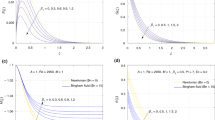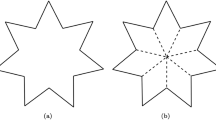Abstract
The goal of this study is to examine the photo-thermoelastic interactions in an infinite semiconducting solid cylinder with rotation subjected to an exponential laser pulse as a variable heat flux along the boundary surface. A Moore-Gibson-Thompson-Photo-Thermal (MGTPT) equation with hyperbolic two temperatures is used to express the equations that govern heat conduction in deformable bodies based on the difference between conductive and dynamic temperature acceleration. Proposed mathematical model is solved in a transformed domain using the Laplace transform. For computing displacement components, conductive temperature, thermal stresses, and carrier density in the physical domain, numerical inversion is used. A graphic representation of all the parameters are generated using MATLAB software to illustrate the effect of thermal relaxations as well as different theories of thermoelasticity with two temperatures.







Similar content being viewed by others
REFERENCES
J. M. Duhamel, “Memories of the molecular actions developed by changes in temperatures in solids,” Mummy Div. Sav. Acad. Sci Par. 5, 440–498 (1938).
M. Biot, “Thermoelasticity and irreversible thermodynamics,” J. Appl. Phys. 27, 240–253 (1956). https://doi.org/10.1063/1.1722351
C. Cattaneo, “A form of heat-conduction equations which eliminates the paradox of instantaneous propagation,” Comp. Rend. Acad. Sci. Paris, Ser. II 247, 431–433 (1958).
P. Vernotte, “Les paradoxes de la theorie continue de l’equation de lachaleur,” Comp. Rend. Acad. Sci. Paris, Ser. II 246, 3154–3155 (1958).
P. Vernotte, “Some possible complications in the phenomena of thermal conduction,” Comp. Rend. Acad. Sci. Paris, Ser. II 252, 2190–2191(1961).
H. W. Lord and Y. Shulman, “A generalized dynamical theory of thermoelasticity,” J. Mech. Phys. Solids 15, 299–309 (1967). https://doi.org/10.1016/0022-5096(67)90024-5
P. J. Chen and M. E. Gurtin, “On a theory of heat conduction involving two temperatures,” ZAMP 19, 614–627 (1968). https://doi.org/10.1007/BF01594969
A. E. Green and K.A. Lindsay, “Thermoelasticity,” J. Elasticity 2, 1–7 (1972). https://doi.org/10.1007/BF00045689
R. S. Dhaliwal and H.H. Sheriff, “Generalized thermoelasticity for anisotropic media,” Quart. Appl. Math. 38, 1–8 (1980). https://doi.org/10.1090/qam/575828
A. E. Green and P. M. Naghdi, “A re-examination of the basic postulates of thermomechanics,” Proc. R. Soc. Lond. Ser. A Math. Phys. Sci. 432, 171–194 (1991). https://doi.org/10.1098/rspa.1991.0012
A. E. Green and P. M. Naghdi, “On undamped heat waves in an elastic solid,” J. Therm. Stress. 15, 253–264 (1992). https://doi.org/10.1080/01495739208946136
A. E. Green and P. M. Naghdi, “Thermoelasticity without energy dissipation,” J. Elasticity 31, 189–208 (1993). https://doi.org/10.1007/BF00044969
I. Lasiecka and X. Wang, “Moore-Gibson-Thompson equation with memory, part II: general decay of energy,” Anal. PDEs. 1–22 (2015). https://doi.org/10.48550/arXiv.1505.07525
R. Quintanilla, “Moore–Gibson–Thompson thermoelasticity,” Math. Mech. Solids 24, 4020–4031 (2019). https://doi.org/10.1177/1081286519862007
R. Quintanilla, “Moore-Gibson-Thompson thermoelasticity with two temperatures,” Appl. Eng. Sci. 1, 100006 (2020). https://doi.org/10.1016/j.apples.2020.100006
J. R. Fernández and R. Quintanilla, “Moore-Gibson-Thompson theory for thermoelastic dielectrics,” Appl. Math. Mech. 422, 309–316 (2021). https://doi.org/10.1007/S10483-021-2703-9
N. Bazarra, J. R. Fernández, and R. Quintanilla, “Analysis of a Moore-Gibson-Thompson thermoelastic problem,” J. Comput. Appl. Math. 382, 113058 (2021). https://doi.org/10.1016/j.cam.2020.113058
H. M. Youssef, “Theory of generalized thermoelasticity with fractional order strain,” J. Vib. Contr. 22, 3840–3857 (2016). https://doi.org/10.1177/1077546314566837
H. M. Youssef and A. A. El-Bary, “Theory of hyperbolic two-temperature generalized thermoelasticity,” Mater. Phys. Mech. 40, 158–171 (2018). https://doi.org/10.18720/MPM.4022018_4
I. Kaur, K. Singh, and E.-M. Craciun, “A mathematical study of a semiconducting thermoelastic rotating solid cylinder with modified Moore–Gibson–Thompson heat transfer under the hall effect,” Math. 10, 2386 (2022). https://doi.org/10.3390/math10142386
I. Kaur, P. Lata, and K. Singh, “Memory-dependent derivative approach on magneto-thermoelastic transversely isotropic medium with two temperatures,” Int. J. Mech. Mater. Eng. 15, 10 (2020). https://doi.org/10.1186/s40712-020-00122-2
I. Kaur, K. Singh, and E.-M. Craciun, “New modified couple stress theory of thermoelasticity with hyperbolic two temperature,” Math. 11, 432 (2023). https://doi.org/10.3390/math11020432
I. Kaur, K. Singh, and E.-M. Craciun, “Recent advances in the theory of thermoelasticity and the modified models for the nanobeams: a review,” Discov. Mech. Eng. 2, 2 (2023). https://doi.org/10.1007/s44245-023-00009-4
I. Kaur, K. Singh, G. M. D. Ghita, and E.-M. Craciun, “Modeling of a magneto-electro-piezo-thermoelastic nanobeam with two temperature subjected to ramp type heating,” Proc. Roman. Acad., Ser. A 23, 141–149 (2022).
E. M. Craciun, E. Baesu, and E. Soós, “General solution in terms of complex potentials for incremental antiplane states in prestressed and prepolarized piezoelectric crystals: Application to Mode III fracture propagation,” IMA J. Appl. Math. 70, 39–52 (2005). https://doi.org/10.1093/IMAMAT/HXH060
N. D. Cristescu, E. M. Craciun, and E. Soós, Mechanics of Elastic Composites (Chapman and Hall/CRC, New York, 2003). https://doi.org/10.1201/9780203502815
P. Lata, I. Kaur, and K. Singh, “Deformation in transversely isotropic thermoelastic thin circular plate due to multi-dual-phase-lag heat transfer and time-harmonic sources,” Arab J. Basic Appl. Sci. 27, 259–269 (2020). https://doi.org/10.1080/25765299.2020.1781328
M. Jafari, M.H.B. Chaleshtari, H. Abdolalian, et al., “Determination of forces and moments per unit length in symmetric exponential fg plates with a quasi-triangular hole,” Symmetry 12, 834–850 (2020). https://doi.org/10.3390/sym12050834
I. Kaur and K. Singh, “A study of influence of hall effect in semiconducting spherical shell with Moore-Gibson-Thompson-photo-thermoelastic model,” Iran. J. Sci. Technol. Trans. Mech. Eng. (2022). https://doi.org/10.1007/s40997-022-00532-x
I. Kaur and K. Singh, “Plane wave in non-local semiconducting rotating media with Hall effect and three-phase lag fractional order heat transfer,” Int. J. Mech. Mater. Eng. 16, 1–16 (2021). https://doi.org/10.1186/S40712-021-00137-3/FIGURES/16
I. Kaur and K. Singh, “The two-temperature effect on a semiconducting thermoelastic solid cylinder based on the modified Moore – Gibson – Thompson heat transfer,” St. Petersbg. Polytech. Univ. J. Phys. Math. 16, 65–81 (2023). https://doi.org/10.18721/JPM.16106
E. M. Craciun, A. Carabineanu, and N. Peride, “Antiplane interface crack in a pre-stressed fiber-reinforced elastic composite,” Comput. Mater. Sci. 43, 184–189 (2008). https://doi.org/10.1016/j.commatsci.2007.07.028
S. Malik, D. Gupta, K. Kumar, et al., “Reflection and transmission of plane waves in nonlocal generalized thermoelastic solid with diffusion,” Mech. Solids 58, 161–188 (2023). https://doi.org/10.3103/S002565442260088X
A. M. S. Mahdy, K. Lotfy, M. H. Ahmed, et al., “Electromagnetic Hall current effect and fractional heat order for microtemperature photo-excited semiconductor medium with laser pulses,” Results Phys. 17, 103161 (2020). https://doi.org/10.1016/j.rinp.2020.103161
A. E. Abouelregal and D. Atta, “A rigid cylinder of a thermoelastic magnetic semiconductor material based on the generalized Moore–Gibson–Thompson heat equation model,” Appl. Phys. A Mater. Sci. Proc. 128, 1–14 (2022). https://doi.org/10.1007/S00339-021-05240-Y/TABLES/7
W. H. Press, S. A. Teukolsky, and B. P. Flannery, Numerical Recipes in Fortran (Cambridge Univ. Press, Cambridge, 1980).
ACKNOWLEDGMENTS
Not applicable
Funding
No fund /grant / scholarship has been taken for the research work
Author information
Authors and Affiliations
Corresponding authors
Ethics declarations
CONFLICT OF INTEREST
The authors declare that they have no conflicts of interest.
AUTHORS’ CONTRIBUTIONS
Iqbal Kaur: Idea formulation, Conceptualization, Formulated strategies for mathematical modelling, methodology refinement, Formal analysis, Validation, Writing- review and editing.
Kulvinder Singh: Conceptualization, Effective literature review, Experiments and Simulation, Investigation, Methodology, Software, Supervision, Validation, Visualization, Writing - original draft.
Both authors read and approved the final manuscript.
About this article
Cite this article
Kaur, I., Singh, K. Modified Moore–Gibson–Thompson Thermoelastic Model with Hyperbolic Two Temperatures Effect on Semiconducting Thermoelastic Solid Cylinder. Mech. Solids 58, 1723–1737 (2023). https://doi.org/10.3103/S0025654423600745
Received:
Revised:
Accepted:
Published:
Issue Date:
DOI: https://doi.org/10.3103/S0025654423600745




